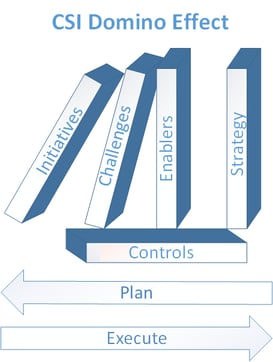CIOs & IT Managers under Pressure to Create Value
As an IT worker, it’s tough to put out the routine fires, take on more workload, keep pace with technology change, be expected to make service improvements and while reducing costs and resources.
Cloud computing now makes it possible for the business to bypass IT and directly buy the services they want, when they need them, inexpensively and with reasonably good quality.
CIOs and IT Managers are under extreme pressure to create, deliver and demonstrate business value like never before.
Create Value Faster with More Focus
Part 1 in this article will share some tools and techniques for continual improvement that help get the results you need faster using The Domino Effect. Stay tuned for Part 2 - Better planning with Value Canvas tool and Part 3 - Improved management control using a Register tool.

In my opinion, Continual Service Improvement (CSI) is one of the ITIL processes that is often overlooked and applies to all services and processes. It helps improve the overall health of IT service management; continually aligns your services with current and future business needs; and improves the maturity of the enabling processes.
Many organizations don’t have a designated CSI Manager. Maybe due to size or perceived need/urgency “we will get to CSI once the basic processes are up and running and stable”, a good example of Catch 22.
In lieu of a dedicated Manager, I believe all Service Managers and Process Owners need to play the CSI Manager role for their own area of responsibility.
Improvement Process Best Practices that Work
In working with many mature and successful organizations over the years I’ve observed a couple of their best practices related to continual improvement which I’d like to share with you.
- Organizations empower their managers and impart them with a sense of urgency for performing continual improvement.
- Successful managers use a very simple, fast and yet effective method of making performance improvements which I call the Domino Effect.

A domino effect or chain reaction is the cumulative effect produced when one event sets off a chain of similar events. Their continual improvement process has five key components that are set up in a very specific order. First they plan by working backwards from right to left (outcomes to actions). Then they execute the plan by working forwards from left to right (actions to outcomes). It’s just like setting up dominoes backwards from the end-goal then pushing the first one forward to the tipping point and watching everything fall in place.
5 Steps to Create Value
- Develop a strategy by defining the purpose, outcomes and benefits that are important, this helps ensures you get buy-in, support and cooperation in obtaining your wildly important goals.
- Put some controls in place using metrics and analytics that will guarantee your success by tracking your progress using artifacts and evidence.
- Next determine what directly enables the outcomes and benefits, these are typically categorized as people, process, technology and/or information needed to realize your strategy.
- Now assess the enablers to determine what the challenges are going to be, these could be in the form of issues, gaps, risks or even opportunities that must be addressed.
- Finally develop and implement initiatives that directly address the challenges identified in the previous step, solutions should be fit for the original purpose.
During execution the initiatives remove the challenges that prevent the enablers from achieving the strategy while the controls ensure things keep on track.
Ontario Government Case Study
Case in point, Jill Delen was the program manager who successfully improved many IT services for the Ontario Government (OG) using the domino effect. The OG had recently merged many Ministry IT departments into fewer IT Clusters as part of a streamlining effort. This presented significant challenges in delivering quality IT services with the many changes that had taken place.
Jills’ team developed an Integrated Service Agreement Methodology (ISAM) that significantly improved application/infrastructure support services by removing challenges and increasing effectiveness of the Help Desk, 1st line and 2nd line support processes. Being part of Jill’s team, here are the five steps we used:
These steps were repeated on 26 more critical services over an 18 month period. All measured services were dramatically improved and verified.
Let us help you create your Business Value.
In conclusion, all service managers and process owners need to put on their CSI Manager’s hat and create their own domino effect to accomplish their wildly important goals.
Request a free Value Canvas tool and consultation with our experts to overcome your challenges and create business value.
David Smith is the president of Micromation Inc. We help organizations increase customer value through continual improvement of services and processes by minimizing waste while maximizing yield.
David is the author of “Implementing Metrics for IT Service Management” ISBN: 9789087531140 and contributing co-author of "IT Service Management - Global Best Practices" ISBN: 9789087531003.



